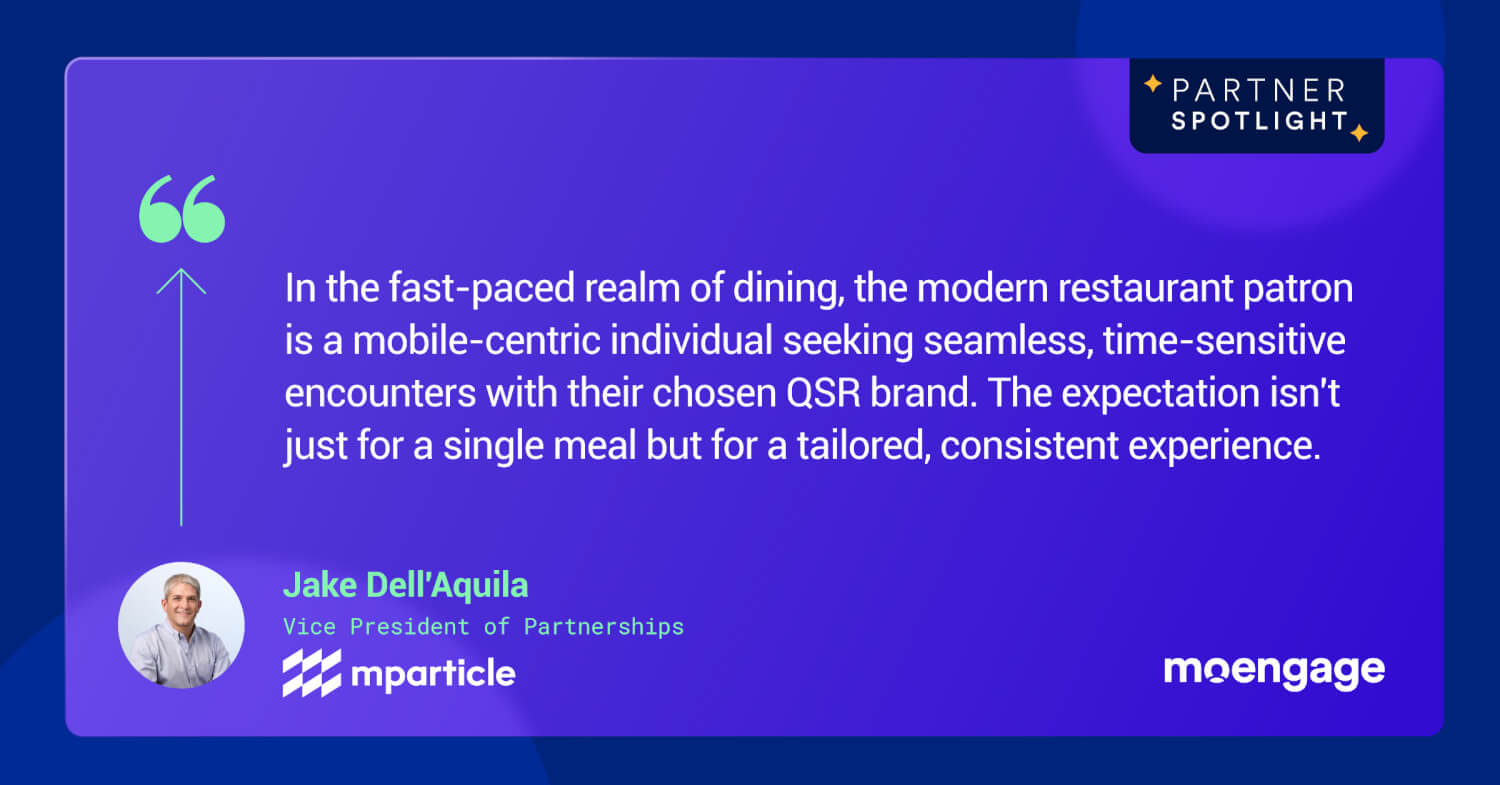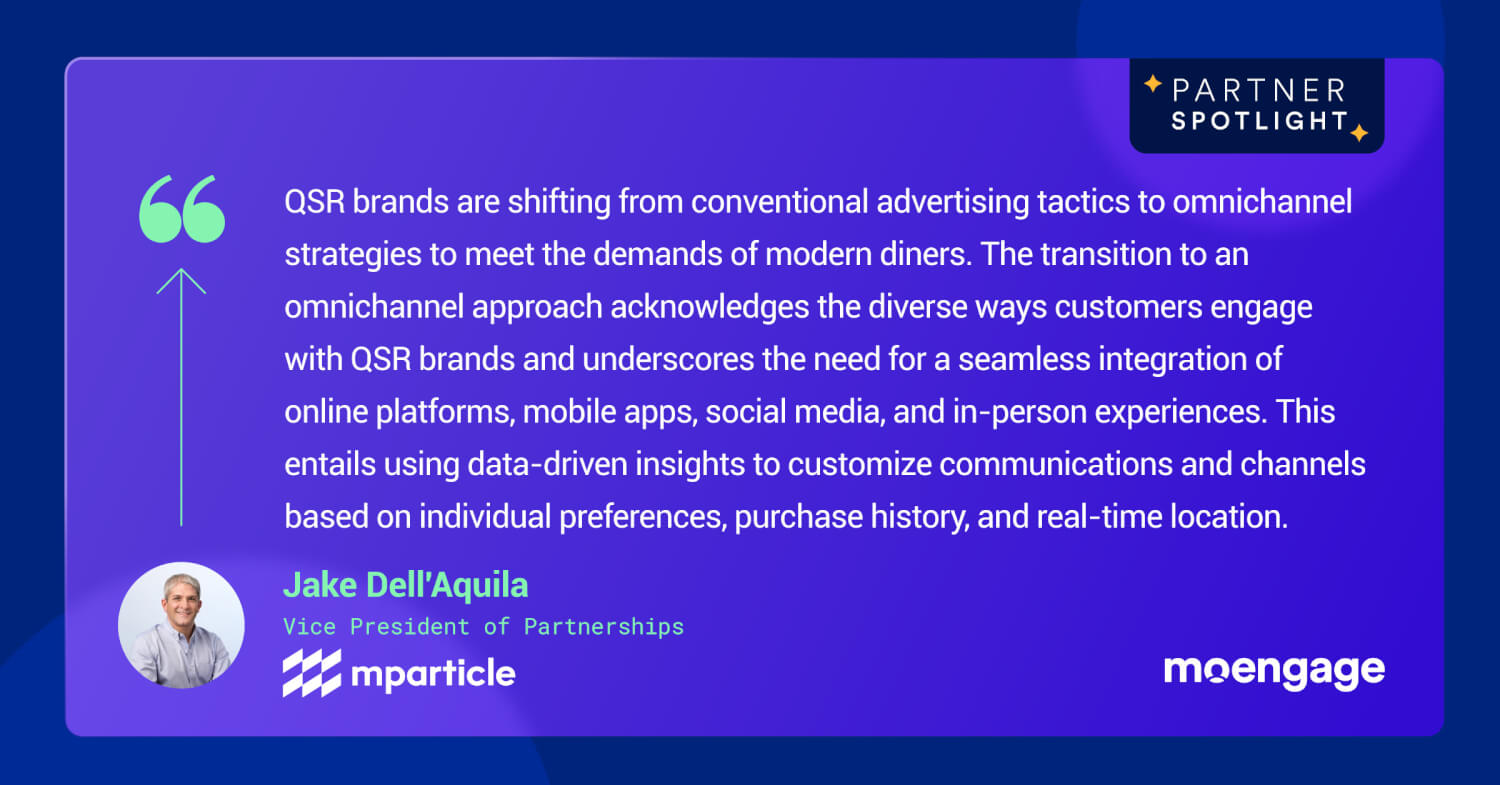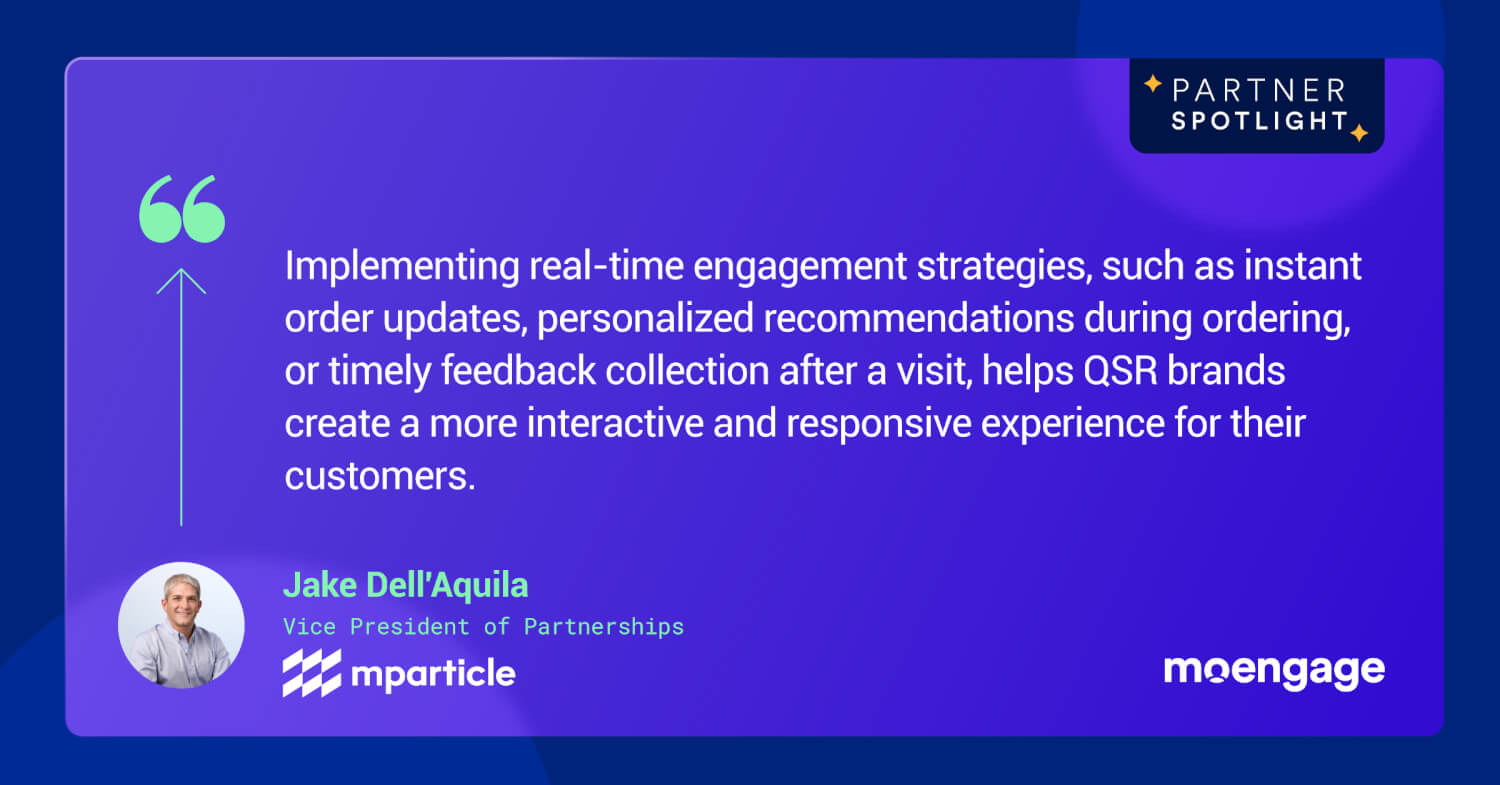[Partner Spotlight] Perfecting Your QSR MarTech Stack by Adding a Customer Data Platform
![[Partner Spotlight] Perfecting Your QSR MarTech Stack by Adding a Customer Data Platform](https://www.moengage.com/wp-content/uploads/Feauture-Image-1200x628-1.jpg)
Reading Time: 7 minutes
| Editor’s Note:
This is the third edition of the Partner Spotlight Series, where we are interviewing thought leaders and sharing their advice on how to perfect your martech stack and improve your engagement strategies to build comprehensive customer experiences. This blog features an interview with Jake Dell’Aquila, Vice President of Partnerships, mParticle, a Customer Data Platform leading the way in real-time customer decisions with AI-powered insights and predictions. Jake has 20 years of experience in tech and business development. He harnesses his expertise to cultivate symbiotic relationships, amplifying mParticle’s global impact and empowering businesses to leverage data effectively. Read on to get his expert advice, tips, and trends to better leverage your marteck stack, especially if you are from the QSR industry. |
Q1. The Quick Service Restaurant (QSR) industry seems to be growing at a good pace in the US and Canada. Do you think QSR brands need to up their customer engagement game? If so, why?
Customer engagement is a pivotal conduit for Quick-Service Restaurant (QSR) brands seeking to enhance the frequency of orders and bolster the average order value. Among the array of strategies available, loyalty and rewards programs emerge as potent tools, leveraging direct incentives to spur growth among the most fervent brand advocates. Yet, while these programs forge a deep connection with loyal patrons, messaging and engagement initiatives wield a broader reach, empowering brands to connect with a diverse audience through targeted and personally relevant communications.
These engagement programs serve as a multifaceted gateway for brands. They transcend the limitations of loyalty-centric approaches by interfacing with customers more individually. Whether or not it directly ties into a loyalty program, these initiatives weave a web of personalized communication that resonates deeply with each recipient. By tailoring messages to suit specific preferences, purchase histories, or behaviors, brands can establish a more profound and resonant connection. This can include promotional updates, personalized recommendations, or interactive content, all aimed at fostering a sense of belonging and relevance for the customer.
Such tailored engagement nurtures brand loyalty and cultivates a sense of inclusivity and understanding. It fosters a dynamic conversation between brand and customer, amplifying the potential for increased order frequency and higher average order values while fortifying brand resonance within the market landscape.
Q2. What are the top 3 emerging trends for customer engagement in the QSR space?
1) Best-of-breed
The transition from an “all-in-one” to a “best-of-breed” approach in marketing tools denotes a significant change in how businesses optimize their strategies. The former involves using a single comprehensive tool encompassing various functionalities, while the latter employs specialized tools for specific functions or aspects of a strategy.
This shift is driven by technological advancements, which have led to the emergence of specialized tools excelling in distinct areas like analytics, engagement, social media management, and customer relationship management.
Understanding this shift is crucial as it signifies a move towards a more strategic and nuanced marketing approach. It also highlights the importance of adaptability, integration capabilities, and a deeper understanding of how various tools complement each other within a marketing ecosystem to drive better outcomes.
Ultimately, the “best-of-breed” approach allows marketers to optimize campaigns more effectively, harnessing the strengths of specialized tools to elevate their overall marketing performance and achieve superior results across multiple channels.
2) Personalized Experiences
In the fast-paced realm of dining, the modern restaurant patron is a mobile-centric individual seeking seamless, time-sensitive encounters with their chosen QSR brand. The expectation isn’t just for a single meal but for a tailored, consistent experience. Meal delivery, curbside pickup, and real-time order updates have become the benchmarks of this immediacy-driven dining landscape.

To thrive in this ecosystem, QSR brands must pivot from traditional approaches and embrace technological evolution. By integrating advanced technology, QSRs can navigate the intricacies of these time-based experiences, ensuring that every customer interaction is swift, personalized, and location-aware.
The cornerstone of this shift lies in orchestrating personalized messages and experiences across multiple channels. This isn’t merely a matter of conveying information; it’s about crafting tailored engagements that resonate with individual preferences and behaviors. It involves leveraging data to understand customer habits, preferences, and context—allowing for the delivery of timely and relevant communications. Whether through mobile apps, social media, or in-person interactions, the goal is to synchronize these touchpoints, providing a cohesive and responsive journey for the on-the-go customer.
QSR brands that adapt to these evolving expectations position themselves as proactive, customer-centric entities. They cater not just to hunger but to the demand for seamless, immediate, and personalized experiences—a testament to their commitment to meeting the dynamic needs of today’s diners.
3) Omnichannel Marketing
QSR brands are shifting from conventional advertising tactics to omnichannel strategies to meet the demands of modern diners. The transition to an omnichannel approach acknowledges the diverse ways customers engage with QSR brands and underscores the need for a seamless integration of online platforms, mobile apps, social media, and in-person experiences. This entails using data-driven insights to customize communications and channels based on individual preferences, purchase history, and real-time location.

The investment in technology isn’t solely about operational efficiency; it’s about meeting elevated expectations for seamless customer experiences. By embracing omnichannel strategies, these brands position themselves not only to attract but also to retain customers by delivering timely, personalized experiences that align with the fast-paced lifestyle of today’s consumers.
Q3. It is clear from the emerging trends that QSR brands need to focus on understanding customer preferences more deeply and offer personalized engagement. How would you suggest they change their data/insights and customer engagement strategy?
Today’s customers expect top-notch service in record time from every service in their lives, including quick-service restaurants. Creating the kinds of experiences that will keep guests coming back for more requires QSRs to create better, more personalized experiences in and out of the store, only made possible by using a customer data layer.
Here are four data-driven strategies QSR brands can adopt to enhance engagement and create personalized experiences:
1) Centralized Customer Data Management:
Establishing a centralized data repository, a Customer Data Platform or a unified data system allows QSR brands to gather and integrate customer information from various touchpoints. This includes online orders, mobile app interactions, loyalty programs, and in-store purchases. Unifying this data provides a comprehensive view of customer behavior and preferences, enabling QSRs to create more accurate customer profiles.
2) Customer Segmentation and Personalization:
Leveraging the collected data, QSR brands can segment their customer base into distinct groups based on behavior, preferences, order history, or demographics. This segmentation allows for tailored and targeted marketing campaigns. By personalizing messaging, promotions, and offers, QSRs can enhance engagement and create more meaningful interactions, driving customer loyalty and repeat visits.
3) Experimentation of Omnichannel Engagement:
Experimenting with different communication channels and message formats can be vital. Whether through SMS, mobile apps, social media, or email, QSR brands can analyze which channels resonate best with specific customer segments. This experimentation helps optimize outreach strategies and deliver messages at the right time and through the preferred channels of their audience.
4) Real-Time Engagement and Feedback:
Implementing real-time engagement strategies, such as instant order updates, personalized recommendations during ordering, or timely feedback collection after a visit, helps QSR brands create a more interactive and responsive experience for their customers.

Gathering feedback and adapting in real-time based on customer preferences or complaints demonstrates a commitment to enhancing their experience, fostering loyalty and positive word-of-mouth. By implementing these data-centric strategies, QSR brands can improve their understanding of customers and enhance engagement by delivering personalized, timely, and relevant experiences both within and outside the store environment. This customer-centric approach is pivotal in retaining customers and fostering a deeper connection, increasing satisfaction and repeated patronage.
Q4. When should a QSR brand consider adding tools like a Customer Data Platform (CDP) and Customer Engagement Platform (CEP) in its MarTech Stack?
Establishing and optimizing a customer data and engagement strategy requires the right people, internal processes, and technology platforms. Before considering an investment in any vendor’s toolset, the brand should ensure the right people and processes are available to support it.
As an organization’s growth objectives evolve to include more advanced personalization and engagement strategies, the team should consider the full marketing, loyalty, paid ad, analytics, and other martech stack roadmaps.
If a more capable CEP will help the brand meet its needs over the near-medium term, then a CDP may not be a required investment in the near term.
But, if the brand anticipates running a CEP alongside a loyalty program in a different system, or if it intends to invest in a sophisticated analytics program, then it might be worth prioritizing a CDP that can handle real-time data exchange across a more complex marketing technology stack. This is especially true if the brand uses first-party data to guide paid media targeting or to personalize digital products in real-time.
Q4. Why should a QSR brand integrate its Customer Data Platform and Customer Engagement Platform?
Integrating a QSR brand’s CDP and CEP is pivotal for creating a seamless, holistic approach to customer engagement.
Here are some top use cases illustrating the significance of this integration:
1) Unified Customer Profiles:
Integration ensures that customer data collected through various touchpoints—such as mobile apps, online orders, loyalty programs, and in-store interactions—flows seamlessly between the CDP and CEP. This unification creates comprehensive and updated customer profiles. A unified profile allows QSR brands to gain a 360-degree view of customers, including preferences, behaviors, purchase history, and engagement patterns.
2) Personalized Marketing Campaigns:
With integrated platforms, QSRs can leverage enriched customer profiles to create highly personalized marketing campaigns. The CEP can deploy targeted messages, promotions, and offers through various channels by accessing detailed customer insights from the CDP. This personalization enhances customer engagement, increases the relevance of marketing efforts, and drives higher conversion rates.
3) Real-Time Engagement and Feedback Loop:
Integration facilitates real-time interactions with customers. For instance, if a customer places an order via a mobile app, the integrated system can immediately update the CDP with this transaction data. The CEP can then trigger personalized messages, like order confirmations or estimated delivery times. Moreover, integrating feedback mechanisms allows for prompt collection of customer opinions, enabling quick adjustments and improvements in services.
4) Operational Efficiency and Consistency:
Integrating the CDP and CEP streamlines processes and ensures consistency in messaging across various channels. This alignment reduces manual efforts in synchronizing data and campaigns between platforms. It also minimizes the risk of delivering conflicting or duplicate messages to customers, enhancing overall operational efficiency.
5) Enhanced Customer Experience:
Ultimately, the integration of these platforms enables QSR brands to provide a more cohesive and delightful customer experience. By leveraging a unified view of customers and deploying personalized, timely engagements, QSRs can exceed customer expectations, foster loyalty, and differentiate themselves in a highly competitive market.
| Thank you, Jake, for sharing your thoughts and advice for QSR brands looking to elevate their customer experience.
Marketers – We hope you were able to take away a few learnings about the state of the QSR industry, top trends, benefits of using a Customer Engagement Platform and Customer Data Platform combination, etc. To know more, you can connect with Jake on his LinkedIn or Twitter. Stay tuned for more such insightful conversations with our partners in the martech space! Signing off, FJ |














